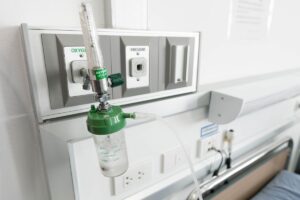Writer: Brittany Pressner
 2 min read September 2021 — Tampa Bay Water has recently requested its residents to cut back on water usage in an effort to mitigate a shortage of liquid oxygen, primarily used for COVID-19 patients on ventilators. This comes at a particularly dire time in Tampa Bay as hospitalizations are at an all-time high and show no signs of decelerating anytime soon.
2 min read September 2021 — Tampa Bay Water has recently requested its residents to cut back on water usage in an effort to mitigate a shortage of liquid oxygen, primarily used for COVID-19 patients on ventilators. This comes at a particularly dire time in Tampa Bay as hospitalizations are at an all-time high and show no signs of decelerating anytime soon.
As of this week, Florida broke its record for hospitalizations, which was preceded by numbers set more than a year ago before vaccines were readily available. Tampa General Hospital reported on its website that as of Sunday, there were 111 COVID-19 admissions, with more than 90% of all intensive care unit beds being occupied by COVID-19 patients. As a result, resources within the hospital system are growing more strained. Tampa hospitals are in need of liquid oxygen in particular as more patients become infected with the Delta variant and are requiring oxygen treatment.
Throughout the pandemic, medical professionals have learned that liquid oxygen can be more effective in treating COVID patients than ventilation. Senior scientist Eric Toner wrote in a January study for the Johns Hopkins Center for Health Security, “COVID-19 patients struggling to breathe have a higher rate of survival when placed on high flow nasal oxygen instead of mechanical ventilation. This treatment requires five to ten times more oxygen than used in a typical ventilator,” which is putting an additional strain on Tampa hospitals already pushed to the brink with COVID patients.
Brandon Moore, spokesperson for Tampa Bay Water, attributes the recent shortage in liquid oxygen to a “driver shortage and an increased demand at hospitals due to the COVID-19 pandemic.”
Tampa Bay Water said it will start using bleach, or sodium hypochlorite, to cleanse its water as opposed to liquid oxygen due the current shortages. Additionally, Greater Tampa’s water department will also utilize different chemicals to clarify its water. The department will change its primary disinfection method to chlorine and will continue to use a mix of ammonia and chlorine for secondary disinfection.
While this may be alarming to some, the county is reassuring residents through a recent notice stating water provided to Tampa Public Utilities customers will continue to meet all local, state and federal regulations for drinking water. According to the notice, “Consumers who are sensitive to taste and odor changes in drinking water might notice a slight change during this period; however, this treatment change will not alter the quality of the drinking water.” As a result of the shortage and needs of Tampa hospitals, Tampa Bay Water is requesting that all residents in the area aid in water conservation efforts by cutting back on non-essential uses like landscaping, sprinklers and car washing. “At this point, it’s great if everyone in our region can conserve water,” said Moore. “If we can reduce water demands, that means there is less to treat, which saves on treatment supplies including liquid oxygen.”
Healthcare isn’t the only field being impacted by the shortage of liquid oxygen. SpaceX rocket launches have also been adversely affected as a result of the shortage. “We certainly are going to make sure the hospitals are going to have the oxygen that they need, but for anybody who has liquid oxygen to spare, send me an email,” President of SpaceX Gwynne Shotwell said during a panel discussion on Tuesday. In response to that statement, Elon Musk tweeted: “This is a risk, but not yet a limiting factor.”

